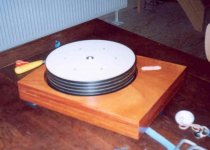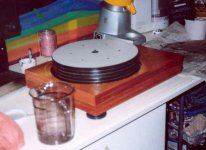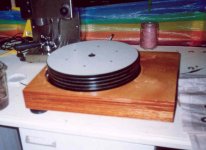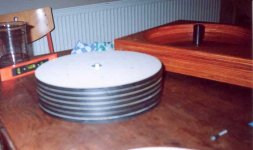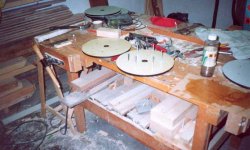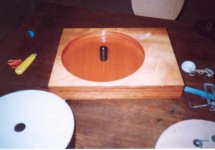strut rods...
I think the unipivot is right way to go. The air bearing is a fun challenging idea to experiment with, which I will continue to do, but for my main TT project I am sticking with the unipivot. I want to use a pushrod from a car engine as my main bearing. I used chro-moly rods in my race car, they are made with extreme precision they're very hard and already have a ball bearing pressed in each end, they also come with bronze or ceramic guide bushings .
I am not abandoning the idea of molding the platter out of vinyl. I want to mold a solid platter, drill (to the appropriate depth,considering CM) the center to accept a rod guide , drop a ball or teflon thrustplate in the hole, press the guide in after it. The rod is pressed into a cylinder drilled in the plinth and the platter slides down the rod. I'd draw a picture but am unfamiliar with CAD, I draft everything by hand (I have my reasons).
Hope you see my vision.
The hydraulic piston rod is a great idea, I may go with this take. It all depends on what I get my hands on first. To be honest I think the strut rod idea is better. Although I am not too keen on the stabilizing wheels, they seem to be overkill, if not more components to cause new problems. I do see the point, but is it necessary?.
I began my project with the idea that I did not need to spend $2000+ for a redpoint if I could build a TT ,using readily available resources, of comperable if not equal quality. My goal is to build TT that can be built by anyone who wants to buid one.
I think the unipivot is right way to go. The air bearing is a fun challenging idea to experiment with, which I will continue to do, but for my main TT project I am sticking with the unipivot. I want to use a pushrod from a car engine as my main bearing. I used chro-moly rods in my race car, they are made with extreme precision they're very hard and already have a ball bearing pressed in each end, they also come with bronze or ceramic guide bushings .
I am not abandoning the idea of molding the platter out of vinyl. I want to mold a solid platter, drill (to the appropriate depth,considering CM) the center to accept a rod guide , drop a ball or teflon thrustplate in the hole, press the guide in after it. The rod is pressed into a cylinder drilled in the plinth and the platter slides down the rod. I'd draw a picture but am unfamiliar with CAD, I draft everything by hand (I have my reasons).
Hope you see my vision.
The hydraulic piston rod is a great idea, I may go with this take. It all depends on what I get my hands on first. To be honest I think the strut rod idea is better. Although I am not too keen on the stabilizing wheels, they seem to be overkill, if not more components to cause new problems. I do see the point, but is it necessary?.
I began my project with the idea that I did not need to spend $2000+ for a redpoint if I could build a TT ,using readily available resources, of comperable if not equal quality. My goal is to build TT that can be built by anyone who wants to buid one.
Illusus, I suspect that worn out car struts are no good, but do you think there is a portion (internal?) that doesn't contact any bushing during use? It would be pretty cool to recycle them.
I also like the threaded end with a nut. That just HAS to make it easier to attach to a plinth! Speaking of nuts, if you are a car nut, it would be appropriate to have a Bilstein turntable!
The pressurized struts should have the most precise rods, but more expensive and dangerous to cut open?
Bernhard points out that a conventional post is a relatively flexible thing. That makes the huge strut rod a big improvement!
Do you rally, road race, autocross?
I also like the threaded end with a nut. That just HAS to make it easier to attach to a plinth! Speaking of nuts, if you are a car nut, it would be appropriate to have a Bilstein turntable!
The pressurized struts should have the most precise rods, but more expensive and dangerous to cut open?
Bernhard points out that a conventional post is a relatively flexible thing. That makes the huge strut rod a big improvement!
Do you rally, road race, autocross?
DIYTT
Guys and Dolls use wood where it is reasonable do not use any metal unless absolutely necessary and linseed oil as surface treatment as the linseed oil is antistatic when it's cured.😉
We have soon reached the magic 10000 views hold on we are comin'
Guys and Dolls use wood where it is reasonable do not use any metal unless absolutely necessary and linseed oil as surface treatment as the linseed oil is antistatic when it's cured.😉
We have soon reached the magic 10000 views hold on we are comin'
All,
sorry, was quite occupied recently. I try to catch up with you.
Happy to see such inspired discussion
Mark,
you got me on the wrong foot, and yes, i did search the forum for any statement or mine concerning 3 minutes, didn't find any. 🙂
What do you mean?
DTopic,
i would love to see you realize your platter air bearing design. How is your mood concerning that? Unipivot or your air bearing?
All again,
i start a new thread dealing with motor and speed measuring topics.
leiade,
you are telling your grandma how to stel horses! 🙂 of course i do use wood whereever possible. I do even use plywood for my new tonearm's fancy framework wand. I prefer birchwood multiplex plywood in the meantime to beechwood and mahogany plywood, i had some samples cut to same size and i knowcked them and looked at the knock oops step response of the knocked wood with my storage scope. Result: Birch playwood has the shortest knock response by far, it seems to have best damping properties and least eagerness to resonate.
But for my air bearing plate, i have settled on precision-ground antimagnetic steel for the stator as well as for the rotor. Glued to a compound with other materials, of course, wood for the stator and vinyl for the platter. I had planned to use glass or precision-ground granite, but the granite parts are


 if i order custom parts, moreover it has not the same density and weight and inertia. Weight for the plinth, inertia for the platter. And I get custommade steel parts way cheaper than i thought. And my platter is approaching the 40kg. 🙂
if i order custom parts, moreover it has not the same density and weight and inertia. Weight for the plinth, inertia for the platter. And I get custommade steel parts way cheaper than i thought. And my platter is approaching the 40kg. 🙂
sorry, was quite occupied recently. I try to catch up with you.
Happy to see such inspired discussion

Variac said:,
3min? I thought it said 3 months! 😉
Wow, the creative juice is flowing again on this site!
Mark,
you got me on the wrong foot, and yes, i did search the forum for any statement or mine concerning 3 minutes, didn't find any. 🙂
What do you mean?
DTopic,
i would love to see you realize your platter air bearing design. How is your mood concerning that? Unipivot or your air bearing?
All again,
i start a new thread dealing with motor and speed measuring topics.
leiade,
you are telling your grandma how to stel horses! 🙂 of course i do use wood whereever possible. I do even use plywood for my new tonearm's fancy framework wand. I prefer birchwood multiplex plywood in the meantime to beechwood and mahogany plywood, i had some samples cut to same size and i knowcked them and looked at the knock oops step response of the knocked wood with my storage scope. Result: Birch playwood has the shortest knock response by far, it seems to have best damping properties and least eagerness to resonate.
But for my air bearing plate, i have settled on precision-ground antimagnetic steel for the stator as well as for the rotor. Glued to a compound with other materials, of course, wood for the stator and vinyl for the platter. I had planned to use glass or precision-ground granite, but the granite parts are



 if i order custom parts, moreover it has not the same density and weight and inertia. Weight for the plinth, inertia for the platter. And I get custommade steel parts way cheaper than i thought. And my platter is approaching the 40kg. 🙂
if i order custom parts, moreover it has not the same density and weight and inertia. Weight for the plinth, inertia for the platter. And I get custommade steel parts way cheaper than i thought. And my platter is approaching the 40kg. 🙂Variac: I road rally race a BMW 325 in an amature class. The car I mentioned was my drag racer, a 62 Chevrolet ( I don't own it anymore).
On topic now...
Wooden bearings???
I love working with wood. I handcarved my headshell for my Ladegaard arm as well as the pivots, there are two, the arm is triangulated. Also the mounts that hold up the entire assembly on the plinth, all oak( it was at hand). I'll post pictures when I finish my TT. I,d like to carve new hardware out of mahogany though.
D.topic. I was playing with an air piston today. I thought the cylinder could be mounted in the plinth and the platter attached to the shaft. The air gap could be controlled by pumping or releasing pressure to/from the cylinder.There is no need for a constant air source , just find the propper pressure and shut off the air flow. The air piston is it's own axial/radial bearing. I'd like to be clearer but I have been awake for a long time ... i'm tired.
... i'm tired.
I need to quit my job so I can test everybody's ideas all day.
On topic now...
Wooden bearings???
I love working with wood. I handcarved my headshell for my Ladegaard arm as well as the pivots, there are two, the arm is triangulated. Also the mounts that hold up the entire assembly on the plinth, all oak( it was at hand). I'll post pictures when I finish my TT. I,d like to carve new hardware out of mahogany though.
D.topic. I was playing with an air piston today. I thought the cylinder could be mounted in the plinth and the platter attached to the shaft. The air gap could be controlled by pumping or releasing pressure to/from the cylinder.There is no need for a constant air source , just find the propper pressure and shut off the air flow. The air piston is it's own axial/radial bearing. I'd like to be clearer but I have been awake for a long time
 ... i'm tired.
... i'm tired.I need to quit my job so I can test everybody's ideas all day.
SKF h5
Hi all,
Forget the gas struts as a sleeve bearing possiblilty the only thing that really works is a SKF precision shaft grade H5 go to SKF web site and search for it but gas struts can sure be used as a shaft for unipivot DIYTT.🙂
Hi all,
Forget the gas struts as a sleeve bearing possiblilty the only thing that really works is a SKF precision shaft grade H5 go to SKF web site and search for it but gas struts can sure be used as a shaft for unipivot DIYTT.🙂
Well, I have seen the DIYaudio TT . When it's done we can all fly in to visit and hear it! Congrats! Somehow I really think getting rid of the sleeve bearing might pay off! It certainly has simplified the construction! The massive center post is encouraging too
Peter, do you have a plan to get the platter very round? I'm tring to think of a clever home method. I wish you could just clamp a high speed drum sander next to it and rotate the platter- but since it tilts, that won't work....hmmmmmm Probably best thing is t o finish the whole thing, then take the platter to a machine shop for a final turning. Congrats again!!!
Peter, do you have a plan to get the platter very round? I'm tring to think of a clever home method. I wish you could just clamp a high speed drum sander next to it and rotate the platter- but since it tilts, that won't work....hmmmmmm Probably best thing is t o finish the whole thing, then take the platter to a machine shop for a final turning. Congrats again!!!


The three minute reference was a joking reference to my punishment. Then I just checked and it was 3 seconds!!!
Sorry to add more confusion🙄 MArk
The discs I used for the platter were made on a big CNC-router at my work. It is normally used to make tabletops. So they are nicely round to begin with. To ensure that they are glued together as concentric as possible I used the six holes in each disc. I put a rod in each hole during assembly. this worked very well. All in all the platter seems to be just as round and well balanced as my Thorens platter. But I agree that to make it really round you will have to turn itPeter, do you have a plan to get the platter very round? I'm tring to think of a clever home method. I wish you could just clamp a high speed drum sander next to it and rotate the platter- but since it tilts, that won't work....hmmmmmm Probably best thing is t o finish the whole thing, then take the platter to a machine shop for a final turning.

I hope this has to do with the fact that everybody is busy making/testing prototypes!!I was thinking this was dying slowly


speaking of prototypes, Is peted still here?  After all he was the first to build something and do some tests. After that it went
After all he was the first to build something and do some tests. After that it went  . Hope he is just too busy 😴
. Hope he is just too busy 😴
 After all he was the first to build something and do some tests. After that it went
After all he was the first to build something and do some tests. After that it went  . Hope he is just too busy 😴
. Hope he is just too busy 😴- Status
- Not open for further replies.
- Home
- Source & Line
- Analogue Source
- Let's make a DIYAUDIO TT
